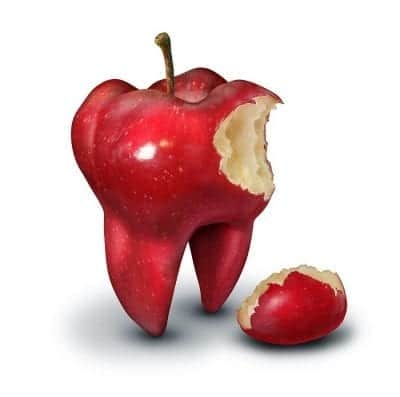You are spending time playing and biting ice inside your mouth when you noticed that there is something hard that did not break down. That hard material can be your chipped tooth.
Chipping a tooth can result from different instances – using your teeth to open packages, eating hard foods, playing some physical sports and being hit in the face or mouth, falling, etc. The enamel is the hardest part of your teeth but can still be damaged because of tooth decay. Tooth decay aids in having you tooth fractured or chipped. Excessive teeth grinding also known as bruxism can also cause a chipped or cracked tooth. One (1) thing that you need to know is that chipped tooth can be very painful and can cause extreme discomfort especially to your tongue.
Others may think that chipped tooth is a common condition and is not too serious. However, there is a chance that the damage caused by the chipped tooth extends beyond the enamel resulting to infection and tooth loss. It your tooth hurts all the time especially when you bite or drink either cold or hot, it may have damaged a nerve or blood vessels.
Did you know that when you break tooth and you still have the piece, it is possible to repair using the chipped tooth? So, set a dental appointment and let your dentist evaluate.
Reducing Injury Until You See Your Dentist

Here are the things that you can do for your chipped tooth while at home and before seeing your dentist.
- To help prevent infection and relieve pain, rinse your mouth with warm salt water.
- When there is bleeding, apply pressure with clean gauze to the affected area. If this does not work, use a teabag to stop bleeding.
- To reduce swelling, place and ice pack on your cheek where the chipped tooth is. Put a clean and thin cloth in between the ice pack and your face.
- It is advisable to use a temporary dental cement on the chipped tooth is your dentist is not available yet.
- When you chipped your tooth, it can be sharp that it might hurt your tongue or cheeks. Put sugarless gum or dental wax to the chipped tooth to keep it from cutting your tongue or the inside of your lip and cheek.
- If you cannot tolerate the pain, take an over-the-counter medication such as acetaminophen. You may also apply clove oil to the painful gums to numb the area.
- Consume soft foods. Avoid biting down on the broken tooth.
- Use dental floss to remove food caught between your teeth. Food that stays between your teeth can add to the pressure of chewing.
- While playing physical sports, use protective mouth guard. Do the same if you grind your teeth while sleeping.
Symptoms of a Chipped Tooth

If the chipped tooth is minor and not found in front of your mouth, you might not know that you have it unless your tongue feels it. The symptoms may include:
- Feeling uncomfortable when you run your tongue over the chipped tooth.
- Your gum around the chipped tooth is irritated.
- Biting pressure can cause pain.
Complications of a Chipped Tooth
You will know that there is infection caused by extensive chip reaching the root of your tooth when:
- You feel pain while eating.
- You feel sensitivity to hot and cold food and drinks.
- You have fever.
- Your mouth tastes sour. This can also cause bad breath.
- Your glands in neck and jaw area are swollen.
You must contact your dentist to receive appropriate dental assistance. The sooner the treatment is provided, the better the chances that you will have in limiting any severe dental problems (and lowering dental treatment costs as well).
Risks of a Chipped Tooth
Our teeth are unbelievably strong but there are still things that can reduce its strength, such as the following:
- Tooth decay and cavities.
- Teeth grinding especially when you are asleep.
- Eating too much acid-producing food and drinks like fruit juices, coffee, and any spicy food.
- Acid reflux and heartburn are two (2) digestive conditions that can bring stomach acid up into your mouth.
- Excessive alcohol intake can cause vomiting which can produce acids.
- Sugars from sweet food and drinks produce bacteria that attack the enamel.
- According to a study from Journal of Endodontics, if you are 50 years old and above, tooth enamel goes weak which can cause a chipped tooth.
Whatever reason we have, we should take care of our overall health to avoid chipped tooth.
How Dentists Repair Chipped or Cracked Tooth
The treatment for a broken tooth or chipped tooth often depends on the extent of damage. If only a small piece of enamel broke off, the repair will be easy and quite simple. However, when the tooth is badly damaged, the repair may take a lengthy procedure and it may be costly. There are several types of tooth breaks and each break has their own dental repair practice.
- Minor cracks or craze lines are cracks that affect only the enamel. This type of crack rarely needs a treatment. Your dentist may lightly polish the area to smooth out any rough or sharp parts.
- Cracked tooth is fracture that involves the whole tooth including the nerve. The pieces remain in place but the crack eventually spreads. This can be repaired through filling. It may also need a crown to prevent the crack from getting worse. If the nerve and other tissues are damaged, you may need root canal too.
- Chips like minor cracks do not always need a treatment. Your dentist may suggest repairing the damage through filling for your tooth to feel and look better. It may also be polished to smooth out the chipped area.
- Broken cusp is a break that affects the chewing surface of the teeth (called cusp). This does not affect the pulp (nerve and other live tissues) and does not cause pain. This can be repair by restoring the tooth’s shape. Crown may be required.
- Serious breaks are those that go deep enough to damage the nerve. You will feel tooth pain and sensitivity. This is a type of break when your tooth bleeds after the accident. Your dentist will have you treated with root canal and a crown.
- Split tooth is the instance wherein the tooth has split vertically into two (2) separate parts. Some teeth like your molars have more than one (1) root. It may be possible to keep one (1) of the roots. Your dentist will tell you that you need a root canal treatment. He will remove roots that cannot be kept. The remaining root will be covered by crown. If the root cannot be saved, the tooth will have to be totally removed.
- Vertical breaks or split root are cracks that start in the root of the tooth and extend upward toward the chewing surface. These breaks can be painful. Your tooth may be removed.
- Decay-induced break is the case when you tooth has broken because a cavity weakened it. Your dentist will check the cavity to recommend the best treatment to restore your tooth. If the decay is too extensive, your tooth may be removed.
Here are some ways on how your dentist can repair your chipped tooth:
- The chipped tooth can be polished to smooth out the jagged edges.
- Fillings can be placed to repair chipped molars, while bonding will be done if the broken tooth is in front.
- Tooth reattachment is performed when you still have the tooth fragment that broke off. Place it in a glass of milk. The calcium content of the milk will keep the tooth fragment alive. Your dentist may be able to cement the fragment back onto your tooth.
- For uncomplicated chips, your dentist may suggest bonding. Bonding uses tooth-colored composite resin. It is a simple procedure where the dentist scratches the surface with a liquid or gel to roughen and use a bonding material to follow the shape. Application of adhesive material and the tooth-colored resin are the next steps. Lastly, the dentist will use an ultraviolet light to harden the material. Bonding can last up to ten (10) years.
- If there is an extensive damage or the tooth has a lot of decay, crown or cap may be required. The dentist may grind the remaining tooth and cover it with a crown or cap which are made to protect the tooth and improve the appearance. There are different types of materials used in creating crowns – metal, porcelain fused to metal, all resin, or all ceramic. Metal crowns are the strongest while porcelain and resin look the same as the original tooth. This treatment will take two (2) visits as your dentist may require dental X-rays to check the roots, tooth, and the surrounding bone. The dentist will numb your gums and tooth to remove the remaining tooth and make the area available for the crown. Filling material can also be used to hold the crown. This is your temporary crown. On the second visit, which is two (2) to three (3) weeks after, your dentist will replace the temporary crown to check if the permanent will fit before cementing it. There are dental offices that already have special digital milling technology. Using this will take only one (1) day to do the crowning procedure.
- Porcelain veneers can also be a treatment especially when a front tooth is broken. Dental veneers are thin shell of tooth-colored porcelain that covers the whole front of the tooth. Your dentist will remove 0.3 to 1.2 millimeters of your enamel. Your dentist will create the veneer. When it is ready, your dentist will scratch the tooth surface with liquid to make it rough. The dentist will apply a special cement to the veneer and veneer will be placed on the prepared tooth. When the veneer is already in position, the dentist will use a special light to activate chemicals that will help in hardening. Dental veneers can last from ten (10) to 20 years according to the study published in 2012 in the International Journal of Prosthodontics.
- Root canal may be performed to clean the inside of the tooth and seal the area if there is an extensive damage. Root canal is performed if the break is large enough to reach the pulp, which contains nerves and blood vessels. The bacteria in the mouth can infect the pulp. If you feel sensitive to heat and your tooth hurting and notice that there is a change in color, the tooth may be infected. This therapy involves removing the dead pulp, cleaning the root canal, and sealing it. Endodontists are normally the ones who perform this procedure.
- Another dental procedure – often considered as a last resort – is tooth extraction. There are two (2) types of extraction – simple and surgical. For this instance, surgical may be appropriate since the chip has spread below the surface of your gums. This requires a lot of planning. You may take pain relievers prior to the surgery.
- The American Dental Association (ADA) suggests that if your tooth has cracked just before the surface of the gumline, your tooth should be removed and replaced with a dental implant. When the tooth is removed and the area has healed, your dentist will add a metal post in the gumline before putting the implant on. This dental implant looks and feels like a real tooth. This will prevent you from infection and a future root canal treatment. This will take several weeks or months as your mouth will need ample time to heal.
Make sure to see your dentist right away if your chipped or broken tooth is bleeding. Your dental partner can move mountains to save your tooth – and, ultimately, your dental health.

Thantakit International Dental Center is Thailand’s longest established dental center, and is trusted by clients from all over the world for world-class dental care. Situated in Bangkok, the clinic has been an established destination for its decades of unparalleled dental services, with many clients flying in to Bangkok from Australia. It offers a complete range of dental services for all ages and needs.
Get FREE dental consultation by getting in touch with Thantakit today!












